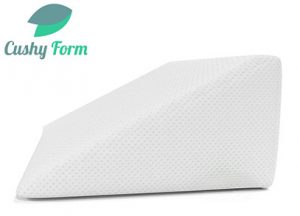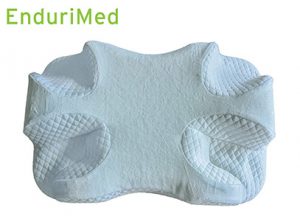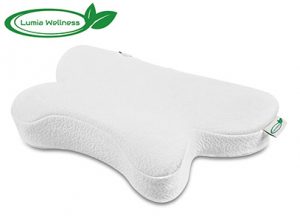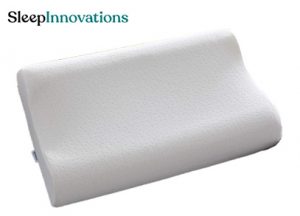Are you one of the estimated 936 million people1 throughout the world living with obstructive sleep apnea (OSA)? Unfortunately, many people with this sleep disorder go undiagnosed or misdiagnosed. If you’ve been told you snore at night or wake up feeling like you haven’t slept at all, this should be a motivation to seek the appropriate diagnosis and treatment.
The standard treatment for this condition at this time is a continuous positive airway pressure (CPAP) machine, but lifestyle changes can help too. Your sleeping position2 affects your airways, and obstructive sleep apnea causes the airways to collapse during sleep, leading to pauses in breathing. It often goes hand-in-hand with snoring. Positioning yourself on your side can help the airways stay open to reduce snoring and alleviate mild apnea. Having a pillow that may help with positional therapy might be beneficial. Keep reading to see our top 5 picks for the highest-rated pillow for obstructive sleep apnea and some great info about how they help.
Top Rated Pillows for Obstructive Sleep Apnea
- Relax Home Life – Best Wedge
- Cushy Form – Best Multi-Use
- EnduriMed – Best CPAP Machine Compatibility
- Lumia Wellness – Best Basic CPAP Compatibility
- Sleep Innovations – Best Cervical Contour
Sleep Advisor’s Testing Methodology
At Sleep Advisor, our product reviews are based on findings from in-person tests that allow us to have a genuine understanding of how the mattress feels and performs.
For this roundup, we prioritized features that are especially important for pillows for sleep apnea. We paid special attention to components such as pillow thickness, support elements, material, and cooling features.
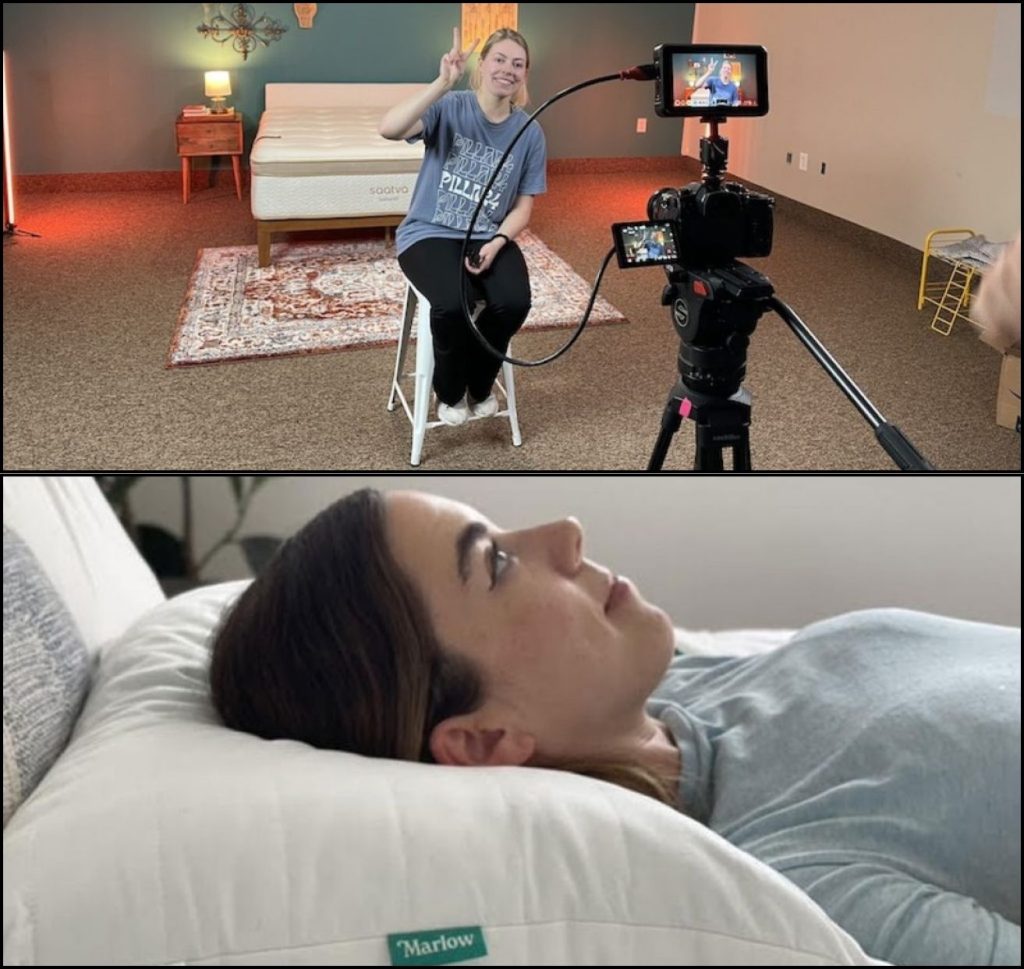
Advice from a Medical Expert
We reached out to Dr. Raj Dasgupta, who has over 20 years of experience in the medical field, to see his thoughts on what key qualities people with obstructive sleep apnea should look for in a pillow.
“When picking a pillow to help with OSA, go for one that keeps your head and neck aligned with your spine, isn’t too soft, molds to your shape for support, and is made of breathable materials to keep you cool. If allergies are a concern, look for a hypoallergenic option. And if you can, choose a pillow with adjustable features for personalized comfort.”
5 Top Rated Pillows for Obstructive Sleep Apnea Reviewed
Relax Home Life – Best Wedge
Relax Home Life 7.5 Pillow
Why Relax Home Life Earned Best Wedge Pillow for Obstructive Sleep Apnea?
This triangle-shaped wedge pillow by Relax Home Life features an industry-leading design for comfort and results. If you’re a back sleeper, having your head and neck lay flat may result in blocked airways, which is where this wedge pillow can help. Sleeping with the head elevated may improve breathing and reduce snoring3 by promoting an open airway. For this reason, we think this pillow could be helpful for those with obstructive sleep apnea.
What is the Relax Home Life Pillow Made Of?
This wedge pillow features a 1.5-inch memory foam top layer for comfort and pressure relief. The firm base consists of premium-grade polyurethane (poly) foam for strong support. Plus, the breathable cover makes it a good option for hot sleepers as it’s made from soft and luxurious bamboo viscose.
Our Take
We think this wedge pillow could be most helpful for those who like sleeping on their back. When you’re not sleeping, you can prop it behind you to get more support when reading or watching TV. However, we wouldn’t recommend it for stomach sleeping.
What We Liked
- Lower incline – The pillow measures 7.5 inches at its tallest point, so it’s not too steep. This means it won’t prop your head or neck too upright to cause neck strain. For back sleepers, the incline should be just enough to reduce obstructive sleep apnea and snoring without causing any neck pain, even if you spend the entire night in this position. We even think some side sleepers may find it comfortable.
- Versatile design – Depending on where on the pillow you choose to lie, you can get a different level of elevation. If you sleep closer to the lowest point, you’ll experience only a slight elevation instead of propping yourself all the way to the tallest point of the pillow. When your head is resting on the tallest point, the rest of the pillow supports your back to reduce pressure buildup.
Flaws But Not Dealbreakers
- Strong smell – One of the first things we noticed upon opening the package is the strong smell. The odor is an artificial fragrance that’s supposed to kill the smell coming off the plastic packaging. While the odor isn’t a deal breaker in and of itself, we will say it persists for days and weeks, which may make some people reconsider.
- You may slide off – Since the incline isn’t too high, we think some people may slide off at night. The only way we think you could stay on is if you were in the same position throughout the night. If you were to move or switch positions, you’d likely wake up lower on the pillow, if not entirely off it.
Cushy Form – Best Multi-Use
Cushy Form Wedge Pillow
Why the Cushy Form Earned Best Multi-Use Pillow for Obstructive Sleep Apnea
This product by Cushy Form is a multi-purpose pillow crafted at a 12-inch height. We feel this incline should be enough to keep the airway open and improve symptoms like snoring, OSA, and acid reflux. The firm base is designed to support your neck and torso, promoting optimal spinal alignment. This helps alleviate any pain or discomfort.
While testing it, we tried several positions, including placing the pillow under the knees or between the legs.
What’s the Cushy Form Pillow Made Of?
Sleeping peacefully shouldn’t be a problem with the 1.5-inch high-density memory foam layer on top for added comfort. A soft and breathable cover is included for temperature regulation and can be machine-washed as needed. The memory foam core does a good job of contouring your curves to support the neck, head, and rest of the body in various positions.
Our Take
Not only does this wedge pillow work well for sleeping, but it can be used in many different ways. We found it comfortable in various positions, such as upright behind the beck for support while relaxing or under your legs for better circulation.
What We Liked
- Machine-Washable Cover – It’s always a nice touch when the cover is removable and easy to wash. The Cushy Form pillow has a zipper to remove the cover with ease. The process of removing and putting it back on takes a few seconds, so washing it is not going to be one of those mundane tasks.
- Contouring Memory Foam – This pillow is made from memory foam that offers a nice contour around the neck and head. Even when we placed it between the knees or behind the back, the memory foam still offered enough cushioning and pressure relief without taking away from the support.
Flaws But Not Dealbreakers
- One Size Only – Although the brand offers multiple models, there’s only one size for this particular wedge pillow. That being said, the 12-inch size should work for most people, especially those with sleep apnea and snoring, since it elevates the head quite a bit.
- It May Be Too Hot – The Cushy Form pillow is made entirely out of memory foam, so it may run a bit too hot for some people. The materials feel high-quality and comfortable, but we think it lacks a bit in temperature regulation, which might put hot sleepers off.
EnduriMed – Best CPAP Machine Compatibility
EnduriMed Pillow
Why the EnduriMed Earned Best Obstructive Sleep Apnea Pillow for CPAP Machine Compatibility
If you use a CPAP at night, you’re probably familiar with how frustrating it can be to sleep comfortably without air leaks or kinked tubing. If you’ve ever wished there was a pillow created specifically with CPAP users in mind, you’re in luck. The EnduriMed pillow has four built-in ergonomic mask cutouts, so sleeping comfortably on your back or side shouldn’t be a problem.
What’s the EndurMed Pillow Made Of?
This pillow has a soft memory foam base that cradles your head and neck while the contours provide space for your mask and tubing to lay freely. It’s a 4-in-1 design that offers unique customizations based on your preferences and needs.
Our Take
Bruising from your mask, pressure lines, and interrupted sleep could be a thing of the past with a cushion designed specifically with your comfort in mind. This pillow allows you to change positions from side to side with cutouts on both ends. You can even flip the pillow around for more comfort if you have a smaller frame.
What We Liked
- Patented New Design – One of the best things about this pillow is that it has a removable foam pad meant to increase or decrease thickness. If you think this pillow is too thick or thin, you can use the pad to play around with this loft until you find what fits you best. This design is patented, and we think it works well for those who like to switch things up when it comes to pillow height.
- Two-Sided Construction – The pillow is made to work best for side sleeping, and with a removable pad, we think it should do a good job of filling the gap between your neck and the mattress underneath. However, another thing we liked is that you can rotate the pillow to make it match your body frame better since one side is smaller than the other for those with a smaller body frame.
Flaws But Not Dealbreakers
- Only for CPAP Machines – While this design works great for those who sleep with a CPAP machine, the rest of the folks may not get much out of it. The company claims other nasal masks and devices may be less compatible, given that the pillow is made specifically for CPAP machines.
- No Custom Pillowcases – This pillow has a unique look, and it does come with a cover. However, you may have to use your regular pillowcases with this one since there are no specific ones from the brand. Some customers report that Queen pillowcases work, but that does conceal the design and may reduce its efficiency.
Lumia Wellness – Best Basic CPAP Compatibility
Lumia Wellness Pillow
Why the Lumia Wellness Earned Best Obstructive Sleep Apnea Pillow for Basic CPAP Compatibility
This butterfly-shaped cushion by Lumia Wellness is another example of a design that was custom-made for CPAP users. The contoured shape with side cutouts provides space for the mask to rest freely while reducing pressure and preventing air leaks. The integrated hose straps provide a place to secure tubing, so you have one less thing to worry about.
What’s the Lumia Wellness Pillow Made Of?
A premium organic cotton pillowcase that’s soft and breathable is included with this pillow. This cover is removable for easy machine washing when necessary. The core is made from memory foam that creates a comfortable and supportive sleep experience in various positions. Overall, the pillow is small and lightweight, so it’s perfect for travel or use at home.
Our Take
This product is designed to have the narrow end closer to your neck. Your face should be positioned at the edge, so your mask occupies the open space from the cut-out section. We think it could also work with other sleep devices and masks.
What We Like
- Contoured Shape – The butterfly shape is for more than aesthetics as it makes the pillow fit CPAP machines better. The contoured design should work well for side, back, and stomach sleeping, but keep in mind the 5-inch profile may not work for everyone’s body frame.
- Traditional Memory Foam Feel – This pillow is made from memory foam, so it has a slow response to movement. The foam bounces back to shape when you move, but it does that slowly, allowing just enough sinkage to prevent pressure buildup, especially when sleeping on your side.
Flaws But Not Dealbreakers
- Not for Bigger Body Frames – Since it’s only 5 inches tall, the Lumia Wellness pillow may not be so comfortable for those with a bigger body frame or broader shoulders. Side sleepers, in particular, should be careful whether the pillow fills in the gap between the neck and the mattress.
- Not the Best for Combination Sleepers – Although the pillow does feel comfortable in various sleeping positions, switching between positions felt a little awkward. For example, going from back to side sleeping requires you to move the entire body and recenter to the middle of the pillow.
Sleep Innovations – Best Cervical Contour
Sleep Innovations Contour Pillow
Why the Sleep Innovations Pillow Earned Best Cervical Contour Pillow for Obstructive Sleep Apnea?
Sleep Innovations’ cervical cushion has an “M” shape with one end slightly higher, which is a layout designed to gently cradle the head in the middle and an arch to support the neck. This alignment should keep the head and neck straight, promoting open airways as well. With two levels of contour to choose from, you should be able to find the right fit for your frame.
What’s the Sleep Innovations Pillow Made Of?
This ergonomic pillow is made from memory foam, so it has a slow response. The foam offers plenty of support as it doesn’t allow your head to sink too deeply, which should help keep the neck aligned. On top of that, it has a soft cover you can remove for a quick and easy wash.
Our Take
This therapeutic design is enhanced by adaptive memory foam for additional comfort and support. This product is made in the USA and comes in three sizes: Travel, Standard, and Queen. At just 1.4 pounds, this lightweight cushion should be easy to take with you for a great night’s rest on the go.
What We Liked
- Certified Materials – An important factor for memory foam products and shoppers with allergies is whether the pillow materials are certified. The Sleep Innovations pillow has CertiPUR-US®-certified memory foam, which should be safe for sensitive people to use. On top of that, the materials are hypoallergenic, so that’s an extra benefit if you have allergies.
- Travel Size Available – Another reason we love this pillow? The Travel-size option. The design and feel are the same, but the one meant for travel is slightly smaller and easier to transport. It doesn’t matter if you’re traveling by plane, bus, or car, this pillow could make a significant difference in the overall comfort level you experience while on the road.
Flaws But Not Dealbreakers
- Not for Stomach Sleepers – The curved design feels comfortable for back and side sleeping as the memory foam supports the head and neck to reduce obstructive sleep apnea and snoring. However, that same design may not work for stomach sleepers as the curve feels uncomfortable on the neck and head when on the stomach.
- One Height Option – The Standard and Travel size options have the same profile, measuring 5 inches. Although this should fit most people, it may be a bit too low for people with a bigger body frame. Similarly, side sleepers with broad shoulders may feel the pillow isn’t tall enough to fill the gap between the neck and mattress. This can result in an uncomfortable sleeping position that’s unlikely to help with obstructive sleep apnea.
Who Should Consider Buying a Pillow for Obstructive Sleep Apnea?
People who live with OSA may want to consider buying a pillow designed to help them sleep better with this condition. Some of these pillows have specific cutouts to fit the CPAP machine and its tubes, which can help significantly in how comfortable you feel sleeping with such a device. Even those who don’t sleep with a CPAP machine can benefit from a pillow for OSA, as some models can help decrease symptoms and improve your sleep quality
How to Choose a Pillow for Obstructive Sleep Apnea
There are several types of sleep apnea, one of them being obstructive sleep apnea. OSA is the most common sleep-related breathing disorder, and it occurs when the throat muscles relax and block the airway. People with OSA repeatedly stop and start breathing while they sleep, and this can happen off and on many times during sleep. A sign of obstructive sleep apnea is snoring.
As you search for a new pillow, there are specific features to look out for that can not only help you rest more comfortably but could potentially help with symptoms of OSA, like snoring.
Related review: Best Pillows for Snoring
Materials
The majority of pillows for obstructive sleep apnea are made from memory foam because it’s a material that offers a good balance of support and pressure relief. Memory foam is known for its slow response, so it offers a bit of sinkage to relieve pressure and prevent it from building up. However, even with a bit of sinkage, it doesn’t lose its structure, so you can count on a continuous level of support.
One thing to point out with memory foam is that it can sometimes trap heat, which may be a drawback for people who sleep hot.
Support
Support is crucial for people with OSA because, without it, you may sink too deeply into your pillow. As a result, sleepers could experience neck pain and even difficulty breathing, depending on their preferred sleeping position.
Many pillows for OSA have a medium firmness, so they should give a balance of support and pressure relief. Sleepers can expect a bit of sinkage to relieve the tension in the neck but not too much to throw the spine out of alignment. That being said, stomach sleepers won’t require as much firmness and support as back and side sleepers.
“A pillow can make OSA worse if it’s too soft and causes your head to sink in, possibly blocking your airway. On the flip side, a supportive pillow that keeps your head and neck aligned can help lessen symptoms by reducing the risk of airway obstruction during sleep.”
Dr. Raj Dasgupta
Sleep Position
Research shows that most OSA symptoms show when sleeping on the back4, so it’s best to avoid this position. Back sleeping allows the tongue to fall back, contributing to blocked airways and potentially making symptoms worse. If changing your sleeping position isn’t an option, elevating the head may help.
On the contrary, lying on the side can help to prevent the soft tissues and tongue from blocking the airways, and stomach sleeping works with gravity to prevent obstruction of the airways and symptoms like snoring, though stomach sleeping is commonly discouraged for a variety of reasons, one of which being that it can put added strain on your spine5.
Firmness
Pillows, like mattresses, are available in various firmness options. For OSA, we’d say it’s best to focus on a firmness that allows your head to stay elevated as intended by the pillow’s design. In other words, going for one that’s too soft may allow too much sinkage, which could then result in obstructed airways and snoring. On the other hand, a pillow that’s too firm may cause pressure buildup.
Feel
The overall feel you’ll choose depends entirely on what you prefer and what works best for relieving your sleep apnea symptoms. Some people like a slow-responding memory foam that feels like it’s hugging your head and neck, while others prefer more or less sinkage.
If you’re wearing a CPAP machine, you may have different preferences than someone who doesn’t wear any similar device. For this reason, use your best judgment and make the best of a trial period allowing you to test a pillow.
Temperature
People who sleep hot often find themselves having to flip the pillow to get to the cool side. Even if heat retention isn’t directly correlated to your sleep apnea, having a cooling pillow could allow you to feel more comfortable in general.
How breathable and cooling a pillow is depends on its construction. Some temperature-regulating features include a cooling cover, open-cell structure, and gel infusions.
Loft
The best pillow loft for OSA depends on your preferred sleep position. Side sleepers usually need a higher loft than back sleepers, while stomach sleepers need the lowest loft. However, some people with obstructive sleep apnea like having their head elevated, thus choosing a wedge pillow that can be up to 12 inches tall.
According to research6, elevating the head can help with obstructive sleep apnea symptoms, so don’t be afraid to test higher lofts to help improve your sleep quality.
Comfort
If you are a back sleeper and can’t imagine having to change, the best option may be a wedge to help you improve your breathing in this position. For side sleepers, a cervical pillow can make a huge difference in maintaining an open airway.
Cushions specifically designed for CPAP compatibility can be a welcome option to prevent air leaks and enhance comfort while wearing a mask. Having a built-in space to accommodate the different mask types and tubing can be extremely helpful in getting a good night’s rest.
Read more about pillows for back sleepers and pillows for side sleepers here.
Budget
Like most pillows, prices will vary based on size, type, and materials. Specialty pillows with unique features for CPAP users will generally be more expensive than traditional ones. Most pillows for OSA will accommodate a variety of budgets. As such, we recommend setting a budget for yourself and going with something that’s both of good quality and within your price range.
If you are searching for cheaper options, take a look at our list of best budget pillows.
Off-Gassing
Off-gassing is a common occurrence in mattresses, pillows, and other bedding, especially those made of memory foam. Even though this smell is temporary and normal, it can be difficult to sleep with, especially for people who are sensitive to odors. What you can do is let the pillow vent for a day or two, which is how long it usually takes for off-gassing odors to dissipate.
Cleaning & Care
How extensive it is to clean the pillow will also matter. Ask yourself how important machine washing is for you. Some pillows are fully washable, while others may only have a washable cover or are spot-clean only.
Types of Pillows for Obstructive Sleep Apnea
- Adjustable Pillow – An adjustable pillow has a loose filling that you can remove to make the loft lower or add to make it taller. This is a good option for combination sleepers and those who sometimes prefer to switch the feel of their pillow. Pillows for OSA can also be adjustable, featuring pads to lift or lower the loft since they’re typically made from solid blocks of memory foam or latex.
- Memory Foam Pillow – This is one of the most common materials used to create CPAP pillows. The pressure-relieving nature of memory foam works well for CPAP users and helps prevent air leaks and facial bruising. However, as we pointed out, these can get a bit too hot unless they have additional cooling features since memory foam traps heat.
- Down Pillow – Many people love the feel of sleeping on a feather or down pillow, but these are not the best choice for OSA. This material is very squishy and doesn’t provide adequate support for the head and neck.
- Latex Pillow – Latex pillow is also great for pressure relief and support, although it has a bouncier feel. As such, it may work best for combination sleepers as it has a quicker response and adapts to you as you switch positions. In addition, latex is naturally breathable, so it’s a good option for hot sleepers.
- Hypoallergenic – Hypoallergenic pillows are of great help to people with allergies. These are made from hypoallergenic materials such as organic cotton, natural latex, bamboo, polyester, microfiber, and faux-down alternative. On top of that, it helps to ensure a pillow has eco-friendly and safety certifications.
- Wedge – These pillows work by elevating the upper body to maintain an open airway and alleviate snoring and other symptoms. Wedge pillows can be a good choice for back sleepers who are reluctant to change sleep positions.
- Cervical – Cervical pillows have a contoured shape to keep the head and neck straight, preventing the airways from collapsing. They also work well for relieving pain and tension. In most cases, this design works best for side sleeping.
- CPAP Compatible – With the growing number of CPAP users, specialty pillows are hitting the market with unique designs to accommodate masks and tubing. Many have contours where the mask can rest and straps to keep the tubing in place. Apart from working well with CPAP machines, these can also accommodate other nasal devices and masks.
Best Pillows for Obstructive Sleep Apnea FAQs
Can a pillow really help with obstructive sleep apnea?
A pillow may help with changes for your well-being. Certain sleeping positions can improve symptoms as well, and others can make them worse. We recommend having a product that keeps your head and neck in a neutral alignment with your spine regardless of what position you are in.
The benefits vary from person to person and are dependent on which form of the disorder you have. Positional therapy is only beneficial for obstructive sleep apnea and not for central sleep apnea.
If you already use a CPAP machine but wonder if a cushion can be helpful too, the good news is that it can be. Lifestyle changes can allow for a reduction in pressure settings and are a step towards freedom.
What type of pillow is best for obstructive sleep apnea?
Different pillows work well for different sleeping positions and body types. For side sleepers, we recommend memory foam or cervical pillows. While back-sleeping isn’t recommended for those with OSA, these folks will likely be most comfortable on a wedge pillow to keep their airway more open. Most sleepers, regardless of sleeping position, should be able to find a pillow that fits their needs with a model specifically designed for CPAP compatibility.
What is the best sleeping position for obstructive sleep apnea?
The best sleeping position for sleep apnea is side sleeping, as the airway should remain open and unblocked. However, stomach sleeping is also an option, though it’s not usually recommended.
Our Final Thoughts
If you suspect you have obstructive sleep apnea, the first step is getting a diagnosis. Your doctor can help you decide what treatment options are available and whether lifestyle changes alone could help. This includes positional therapy as a recommendation.
Side sleeping can be extremely helpful in reducing symptoms. With many different options and designs, you should be able to find the right pillow for your needs. Just remember, that preventing the upper airways from getting obstructed is what matters the most, so try to choose something to keep you comfortable and well-supported for the best results.
In case you want to see more products that can help, check out our list of top-rated mattresses for sleep apnea.

Melanie Kassel
Performance Editor
About Author
As Sleep Advisor’s Performance Editor, Melanie writes and edits content throughout the site to ensure it’s accurate, engaging, and up-to-date.
Combination Sleeper
References:
- Benjafield, Adam V., et al. “Estimation of the global prevalence and burden of obstructive sleep apnoea: a literature-based analysis”. National Library of Medicine. 2019.
- Marques MD, Melania., et al. “Effect of Sleeping Position on Upper Airway Patency in Obstructive Sleep Apnea Is Determined by the Pharyngeal Structure Causing Collapse”. Sleep. 2017.
- Danoff-Burg PhD, Sharon., et al. “Sleeping in an Inclined Position to Reduce Snoring and Improve Sleep: In-home Product Intervention Study”. JMIR Formative Research. 2022.
- “Obstructive Sleep Apnea: Assessment and Management in Adults”. Government of British Columbia. 2021.
- “Sleeping positions that reduce back pain”. Mayo Clinic. Last modified January 19, 2024.
- De Barros Souza, Fábio., et al. “The influence of head-of-bed elevation in patients with obstructive sleep apnea”. Sleep & Breathing. 2017.


